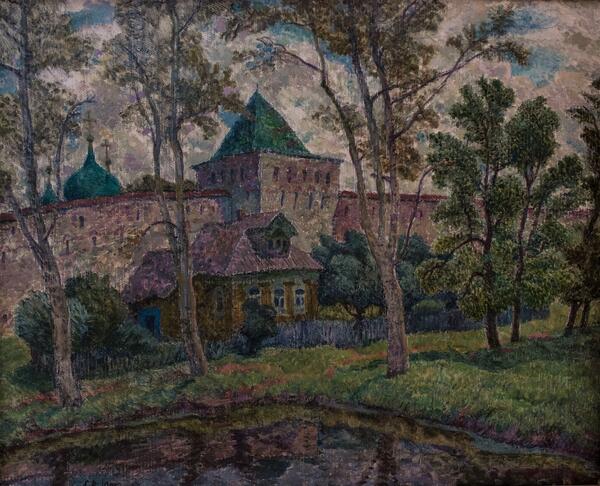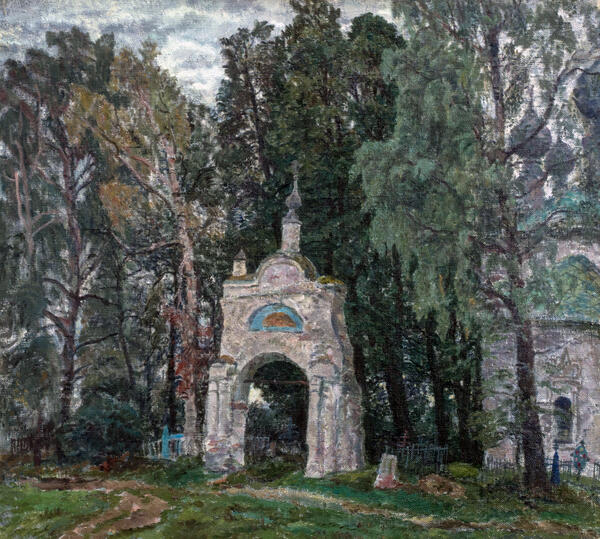The Art Gallery displays the painting “Summer in Borisoglebsky” by a master of realist landscape painting Vyacheslav Stekolshchikov.
In the foreground, the artist depicted an edge of a lake, on the shore of which one can see a small one-story house with an attic. Trees and the water surface create an atmosphere of peace and solitude. Tops of three church domes are visible behind a mighty monastery wall.
The painting shows Borisoglebsky at the River Mouth Rostov male Orthodox Monastery, which is located in the village of Borisoglebsky on the road from Rostov to Uglich. The town is part of the Golden Ring of Russia, a famous tourist route that passes through historic towns of Northeastern Rus.
The monastery was founded in 1363 by monk Feodor, who came from Novgorod lands. Later, monk Pavel joined him with the blessing of St. Sergius of Radonezh. According to the “Chronicle of the Borisoglebsky Monastery”, Sergius of Radonezh himself chose the site for this monastery. The monastery became a spiritual and economic center, around which the Borisoglebsky slobodas were founded — a large trading village, the center of the Borisoglebsky volost (district).
The architectural complex of the monastery had been fully developed before Peter the Great era when it became one of the richest in the Rostov Metropolis and the home monastery of Moscow princes and the first Russian tsars. After the 17th century, the appearance of the monastery practically did not change.
The author of the painting Vyacheslav Stekolshchikov was born in 1938 in Moscow. From 1950 to 1957, he studied at the Moscow Secondary Art School, a base school of the Surikov Moscow State Art Institute. He graduated from the Art Institute in 1963.
During his artistic work assignments, Stekolshchikov traveled to the virgin lands in Kazakhstan, the Arctic, Chukotka, and Kamchatka. He visited the war zone in Africa, in the Republic of Guinea-Bissau, where he “creatively rethought the process of liberation of the African people from Portuguese colonial rule”.
In the foreground, the artist depicted an edge of a lake, on the shore of which one can see a small one-story house with an attic. Trees and the water surface create an atmosphere of peace and solitude. Tops of three church domes are visible behind a mighty monastery wall.
The painting shows Borisoglebsky at the River Mouth Rostov male Orthodox Monastery, which is located in the village of Borisoglebsky on the road from Rostov to Uglich. The town is part of the Golden Ring of Russia, a famous tourist route that passes through historic towns of Northeastern Rus.
The monastery was founded in 1363 by monk Feodor, who came from Novgorod lands. Later, monk Pavel joined him with the blessing of St. Sergius of Radonezh. According to the “Chronicle of the Borisoglebsky Monastery”, Sergius of Radonezh himself chose the site for this monastery. The monastery became a spiritual and economic center, around which the Borisoglebsky slobodas were founded — a large trading village, the center of the Borisoglebsky volost (district).
The architectural complex of the monastery had been fully developed before Peter the Great era when it became one of the richest in the Rostov Metropolis and the home monastery of Moscow princes and the first Russian tsars. After the 17th century, the appearance of the monastery practically did not change.
The author of the painting Vyacheslav Stekolshchikov was born in 1938 in Moscow. From 1950 to 1957, he studied at the Moscow Secondary Art School, a base school of the Surikov Moscow State Art Institute. He graduated from the Art Institute in 1963.
During his artistic work assignments, Stekolshchikov traveled to the virgin lands in Kazakhstan, the Arctic, Chukotka, and Kamchatka. He visited the war zone in Africa, in the Republic of Guinea-Bissau, where he “creatively rethought the process of liberation of the African people from Portuguese colonial rule”.





